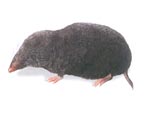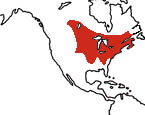|
Northern
Short-tailed Shrew
(Blarina brevicauda) |
||||
|
|
Physical
characteristics and distribution
|
|
The
average head and body length of B. brevicauda is 75-105
mm, tail length is 17-30 mm. Weights range between 15-30. Upper
parts are slate gray with slightly lighter underparts. The eyes
are small and the snout is pointed and the ears are hidden by
the thick furcoat. Females have six mammae, and both sexes have
submaxillary glands which, when a bite is inflicted by B.
brevicauda, secrete a poison that effects the nervous system
of its victim. |
|
Description
of the brain
|
|
Animal
source and preparation
|
|
All specimens collected followed the same preparation and histological procedure.
|
Other Related Resources (websites and publications)
List of Specimens | Explore Collections | Brain Sections | Brain Evolution | Brain Development | Brain Circuitry | Brain Functions | Location and Use | Related Web Sites | Contact Us | Search MSU Database | Personnel | Home



